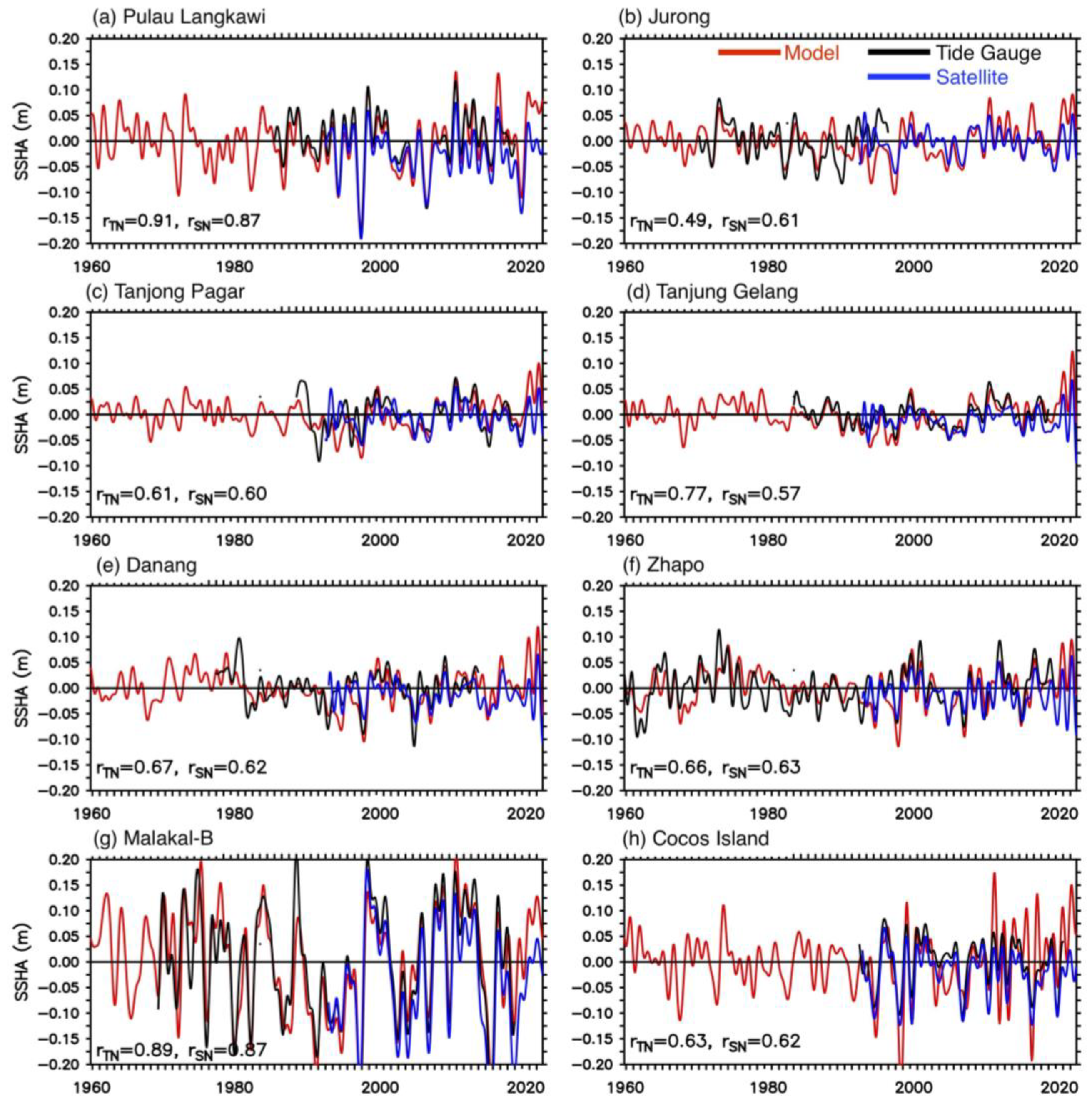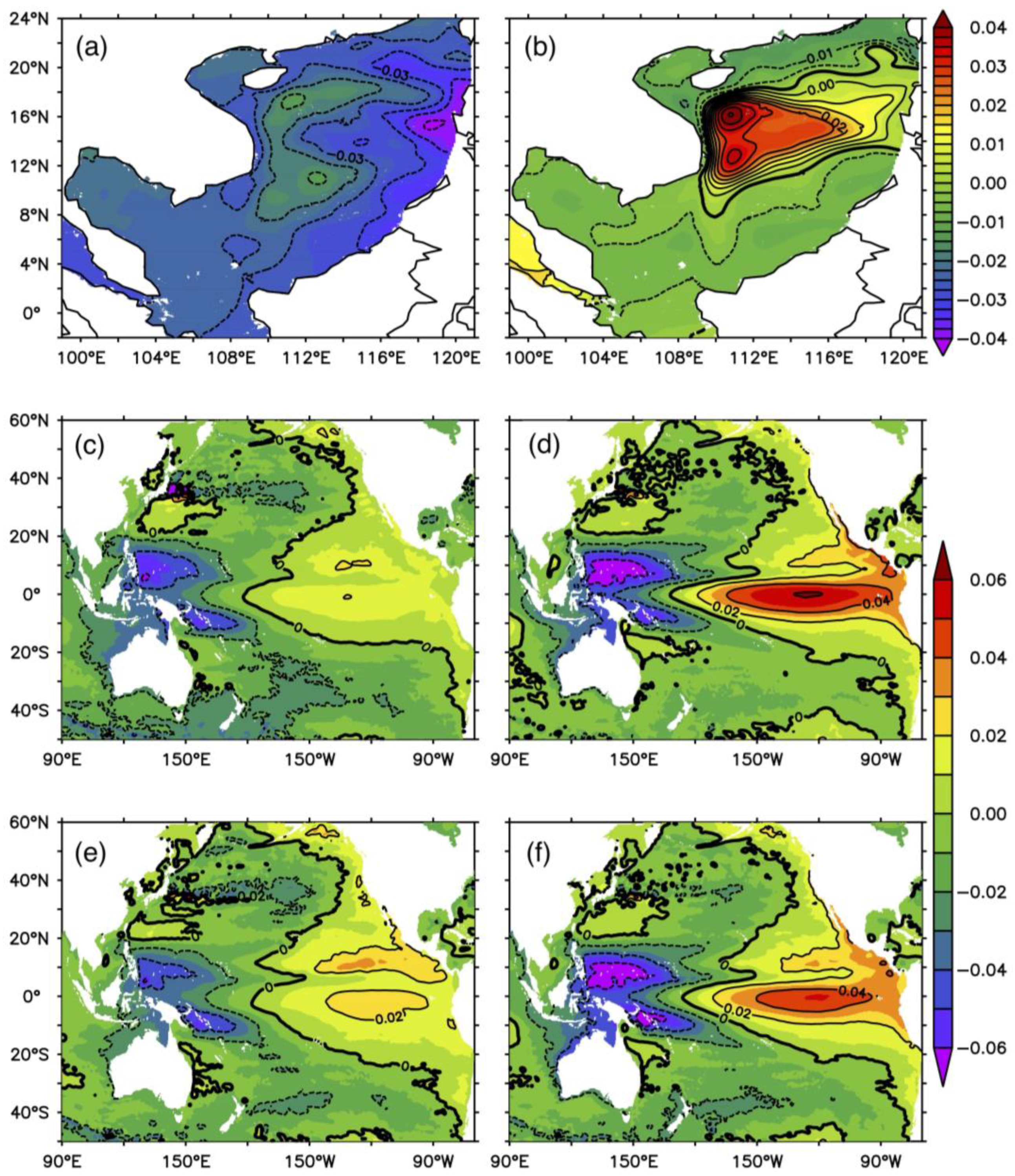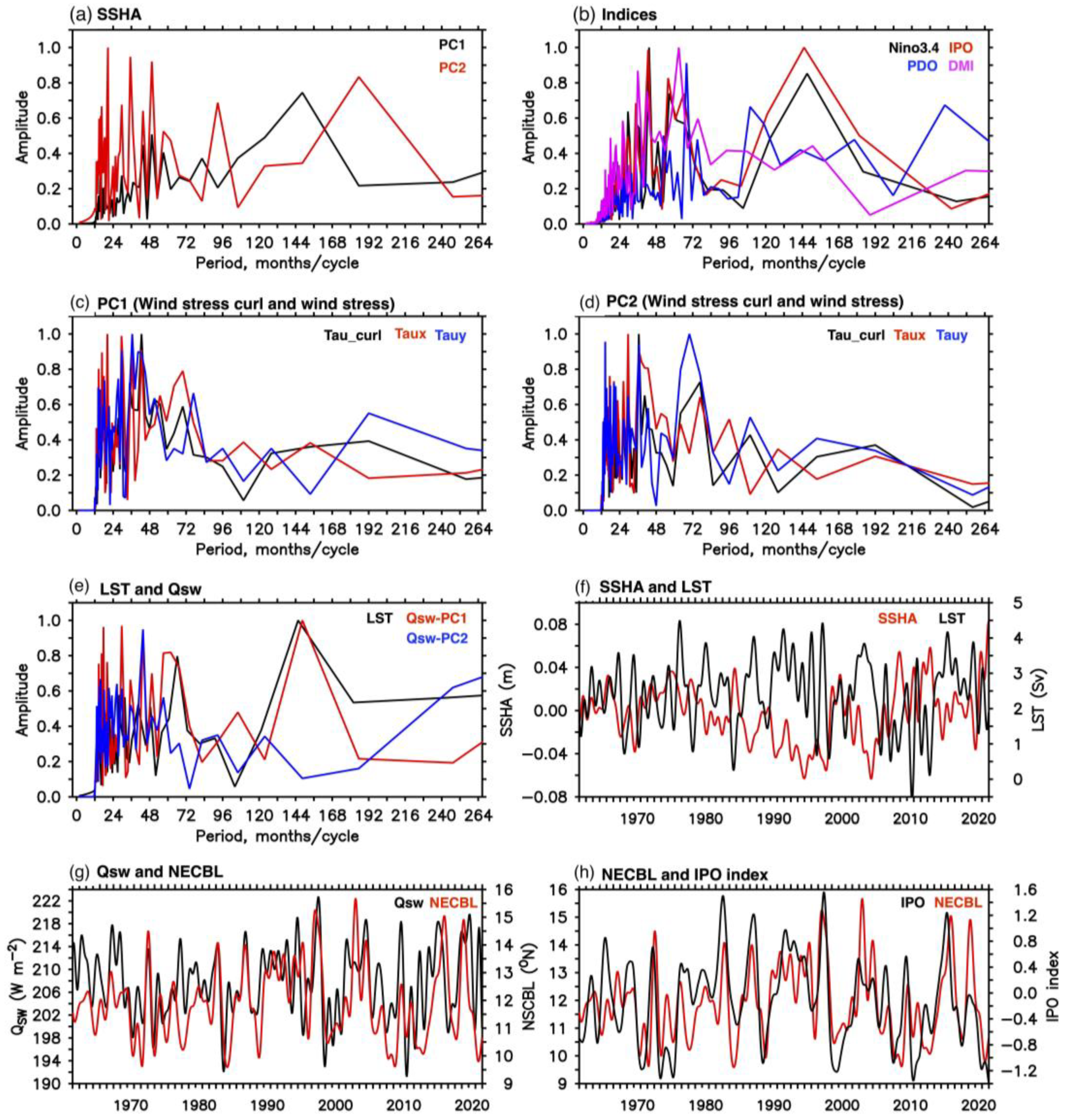Uncovering Interdecadal Pacific Oscillation’s Dominance in Shaping Low-Frequency Sea Level Variability in the South China Sea
Abstract
:1. Introduction
2. Materials and Methods
3. Results and Discussions
3.1. Model Sea Surface Height
3.2. Low-Frequency Sea Level Variability in the SCS
3.3. Role of External Forcing in SCS Sea Level Variability
4. Conclusions
Author Contributions
Funding
Data Availability Statement
Acknowledgments
Conflicts of Interest
References
- Church, J.A.; Woodworth, P.L.; Aarup, T.; Wilson, S.W. Understanding Sea-Level Rise and Variability; Wiley-Blackwell Publishing: Hoboken, NJ, USA, 2010. [Google Scholar] [CrossRef]
- Zhang, X.; Church, J.A. Sea level trends, interannual and decadal variability in the Pacific Ocean. Geophys. Res. Lett. 2012, 39, L21701. [Google Scholar] [CrossRef]
- Royston, S.; Bingham, R.J.; Bamber, J.L. Attributing decadal climate variability in coastal sea-level trends. Ocean Sci. 2022, 18, 1093–1107. [Google Scholar] [CrossRef]
- Frankcombe, L.M.; McGregor, S.; England, M.H. Robustness of the modes of Indo-Pacific sea level variability. Clim. Dyn. 2015, 45, 1281–1298. [Google Scholar] [CrossRef]
- Hamlington, B.D.; Leben, R.R.; Strassburg, M.W.; Nerem, R.S.; Kim, K.-Y. Contribution of the Pacific Decadal Oscillation to global mean sea level trends. Geophys. Res. Lett. 2013, 40, 5171–5175. [Google Scholar] [CrossRef]
- Nidheesh, A.; Lengaigne, M.; Vialard, J. Natural decadal sea-level variability in the Indian Ocean: Lessons from CMIP models. Clim. Dyn. 2019, 53, 5653–5673. [Google Scholar] [CrossRef]
- Qu, T.; Kim, Y.Y.; Yaremchuk, M.; Tozuka, T.; Ishida, A.; Yamagata, T. Can Luzon Strait transport play a role in conveying the impact of ENSO to the South China Sea? J. Clim. 2004, 17, 3644–3657. [Google Scholar] [CrossRef]
- Peng, D.; Palanisamy, H.; Cazenave, A.; Meyssignac, B. Interannual Sea Level Variations in the South China Sea Over 1950–2009. Mar. Geod. 2013, 36, 164–182. [Google Scholar] [CrossRef]
- Soumya, M.; Vethamony, P.; Tkalich, P. Inter-annual sea level variability in the southern South China Sea. Glob. Planet. Change 2015, 133, 17–26. [Google Scholar] [CrossRef]
- Thompson, B.; Tkalich, P.; Malanotte-Rizzoli, P. Regime shift of the South China Sea SST in the late 1990s. Clim. Dyn. 2017, 48, 1873–1882. [Google Scholar] [CrossRef]
- Cheng, X.; Zhao, M.; Duan, W.; Jiang, L.; Chen, J.; Yang, C.; Zhou, Y. Regime shift of the sea level trend in the South China Sea modulated by the tropical Pacific decadal variability. Geophys. Res. Lett. 2023, 50, e2022GL102708. [Google Scholar] [CrossRef]
- Rong, Z.; Liu, Y.; Zong, H.; Cheng, Y. Interannual sea level variability in the South China Sea and its response to ENSO. Glob. Planet. Change 2007, 55, 257–272. [Google Scholar] [CrossRef]
- Deng, W.; Wei, G.; Xie, L.; Ke, T.; Wang, Z.; Zeng, T.; Liu, Y. Variations in the Pacific Decadal Oscillation since 1853 in a coral record from the northern South China Sea. J. Geophys. Res. Ocean 2013, 118, 2358–2366. [Google Scholar] [CrossRef]
- Thompson, B.; Tkalich, P. Mixed layer thermodynamics of the Southern South China Sea. Clim. Dyn. 2014, 43, 2061–2075. [Google Scholar] [CrossRef]
- Xiao, F.; Wang, D.; Yang, L. Can Tropical Pacific Winds Enhance the Footprint of the Interdecadal Pacific Oscillation on the Upper-Ocean Heat Content in the South China Sea? J. Clim. 2020, 33, 4419–4437. [Google Scholar] [CrossRef]
- Cheng, X.; Xie, S.-P.; Du, Y.; Wang, J.; Chen, X.; Wang, J. Interannual-to-decadal variability and trends of sea level in the South China Sea. Clim. Dyn. 2016, 46, 3113–3126. [Google Scholar] [CrossRef]
- Pei, Y.; Zhang, R.H.; Zhang, X.; Jiang, L.; Wei, Y. Variability of sea surface height in the South China Sea and its relationship to Pacific oscillations. Acta Oceanol. Sin. 2015, 34, 80–92. [Google Scholar] [CrossRef]
- Li, J.; Tan, W.; Sun, W.; Yang, L.; Lin, L.; Fu, Q. Seasonal–interannual–decadal variations of sea level in the South China Sea and connections with the tropical–subtropical Pacific. Int. J. Climatol. 2023, 43, 5196–5207. [Google Scholar] [CrossRef]
- Henley, B.J.; Gergis, J.; Karoly, D.J.; Power, S.; Kennedy, J.; Folland, C.K. A tripole index for the interdecadal Pacific oscillation. Clim. Dyn. 2015, 45, 3077–3090. [Google Scholar] [CrossRef]
- Dong, B.; Dai, A.; Vuille, M.; Timm, O.E. Asymmetric Modulation of ENSO Teleconnections by the Interdecadal Pacific Oscillation. J. Clim. 2018, 31, 7337–7361. [Google Scholar] [CrossRef]
- Newman, M.; Alexander, M.; Ault, T.; Cobb, K.; Deser, C.; Di Lorenzo, E.; Mantua, N.; Miller, A.; Minobe, S.; Nakamura, H.; et al. The Pacific Decadal Oscillation, Revisited. J. Clim. 2016, 29, 4399–4427. [Google Scholar] [CrossRef]
- Madec, G. The NEMO Team. NEMO Reference Manual 3_6_STABLE: NEMO Ocean Engine; Note du Pôle de modélisation; Institut Pierre-Simon Laplace (IPSL): Guyancourt, France, 2016; ISSN 1288-1619. [Google Scholar]
- Zuo, H.; Balmaseda, M.A.; Tietsche, S.; Mogensen, K.; Mayer, M. The ECMWF operational ensemble reanalysis-analysis system for ocean and sea ice: A description of the system and assessment. Ocean Sci. 2019, 15, 779–808. [Google Scholar] [CrossRef]
- Chaigneau, A.A.; Reffray, G.; Voldoire, A.; Melet, A. IBI-CCS: A regional high-resolution model to simulate sea level in western Europe. Geosci. Model Dev. 2022, 15, 2035–2062. [Google Scholar] [CrossRef]
- Levier, B.; Tréguier, A.M.; Madec, G.; Garnier, V. Free surface and variable volume in the NEMO code. Tech. Rep. 2007, MERSEA MERSEA IP report WP09-CNRS-STR-03-1A, 47. [Google Scholar]
- Umlauf, L.; Burchard, H. A generic length-scale equation for geophysical turbulence models. J. Mar. Res. 2013, 61, 235–265. [Google Scholar] [CrossRef]
- Canuto, V.; Howard, A.; Cheng, Y.; Dubovikov, M. Ocean turbulence, Part I: One-point closure model-momentum and heat vertical diffusivities. J. Phys. Oceanogr. 2001, 31, 1413–1426. [Google Scholar] [CrossRef]
- Davies, H. A lateral boundary formulation for multi-level prediction models. Q. J. R. Meteorol. Soc. 1976, 102, 405–418. [Google Scholar]
- Flather, R.A. A tidal model of the northwest European continental shelf. Mem. Soc. Roy. Sci. Liege 1976, 10, 141–164. [Google Scholar]
- Edson, J.B.; Jampana, V.; Weller, R.A.; Bigorre, S.P.; Plueddemann, A.J.; Fairall, C.W.; Miller, S.D.; Mahrt, L.; Vickers, D.; Hersbach, H. On the exchange of momentum over the open ocean. J. Phys. Oceanogr. 2013, 43, 1589–1610. [Google Scholar] [CrossRef]
- Hersbach, H.; Bell, B.; Berrisford, P.; Hirahara, S.; Horányi, A.; Muñoz-Sabater, J.; Nicolas, J.; Peubey, C.; Radu, R.; Schepers, D.; et al. The ERA5 global reanalysis. Q. J. R. Meteorol. Soc. 2020, 146, 1999–2049. [Google Scholar] [CrossRef]
- Lengaigne, M.; Menkes, C.; Aumont, O.; Gorgues, T.; Bopp, L.; Madec, J. Bio-physical feedbacks on the tropical pacific climate in a coupled general circulation model. Clim. Dyn. 2007, 28, 503–516. [Google Scholar] [CrossRef]
- Holgate, S.J.; Matthews, A.; Woodworth, P.L.; Rickards, L.J.; Tamisiea, M.E. New data systems and products at the permanent service for mean sea level. J. Coast. Res. 2013, 29, 493–504. [Google Scholar] [CrossRef]
- Van Oldenborgh, G.J.; Hendon, H.; Stockdale, T.; L’Heureux, M.; de Perez, E.G.; Singh, R.; van Aalst, M. Defining El Niño indices in a warming climate. Environ. Res. Lett. 2021, 16, 044003. [Google Scholar] [CrossRef]
- Mantua, N.J.; Hare, S.R.; Zhang, Y.; Wallace, J.M.; Francis, R.C. A Pacific interdecadal climate oscillation with impacts on salmon production. Bull. Am. Meteorol. Soc. 1997, 78, 1069–1079. [Google Scholar] [CrossRef]
- Saji, N.H.; Goswami, B.N.; Vinayachandran, P.N.; Yamagata, T. A dipole mode in the tropical Indian Ocean. Nature 1999, 401, 360–363. [Google Scholar] [CrossRef]
- Luu, Q.H.; Tkalich, P.; Tay, T.W. Sea level trend and variability around Peninsular Malaysia. Ocean Sci. 2015, 11, 617–628. [Google Scholar] [CrossRef]
- Zhao, S.; Jin, F.-F.; Stuecker, M.F. Understanding lead times of warm water volumes to ENSO sea surface temperature anomalies. Geophys. Res. Lett. 2021, 48, e2021GL094366. [Google Scholar] [CrossRef]
- Qiu, B.; Chen, S. Interannual-to-Decadal variability in the bifurcation of the north equatorial current off the Philippines. J. Phys. Oceanogr. 2010, 40, 2525–2538. [Google Scholar] [CrossRef]
- Yaremchuk, M.; Qu, T. Seasonal Variability of the Large-Scale Currents near the Coast of the Philippines. J. Phys. Oceanogr. 2004, 34, 844–855. [Google Scholar] [CrossRef]
- Yang, J.; Lin, X.; Wu, D. Wind-driven exchanges between two basins: Some topographic and latitudinal effects. J. Geophys. Res. 2013, 118, 4585–4599. [Google Scholar] [CrossRef]
- Weiss, T.L.; Linsley, B.K.; Gordon, A.L. Pacific North Equatorial current bifurcation latitude and Kuroshio Current shifts since the last glacial maximum inferred from a Sulu Sea thermocline reconstruction. Quat. Sci. Rev. 2021, 264, 106999. [Google Scholar] [CrossRef]





Disclaimer/Publisher’s Note: The statements, opinions and data contained in all publications are solely those of the individual author(s) and contributor(s) and not of MDPI and/or the editor(s). MDPI and/or the editor(s) disclaim responsibility for any injury to people or property resulting from any ideas, methods, instructions or products referred to in the content. |
© 2024 by the authors. Licensee MDPI, Basel, Switzerland. This article is an open access article distributed under the terms and conditions of the Creative Commons Attribution (CC BY) license (https://creativecommons.org/licenses/by/4.0/).
Share and Cite
Thompson, B.; Tkalich, P.; Faller, D.G.; Zachariah, J. Uncovering Interdecadal Pacific Oscillation’s Dominance in Shaping Low-Frequency Sea Level Variability in the South China Sea. Geosciences 2024, 14, 251. https://doi.org/10.3390/geosciences14100251
Thompson B, Tkalich P, Faller DG, Zachariah J. Uncovering Interdecadal Pacific Oscillation’s Dominance in Shaping Low-Frequency Sea Level Variability in the South China Sea. Geosciences. 2024; 14(10):251. https://doi.org/10.3390/geosciences14100251
Chicago/Turabian StyleThompson, Bijoy, Pavel Tkalich, Daiane G. Faller, and Johnson Zachariah. 2024. "Uncovering Interdecadal Pacific Oscillation’s Dominance in Shaping Low-Frequency Sea Level Variability in the South China Sea" Geosciences 14, no. 10: 251. https://doi.org/10.3390/geosciences14100251





